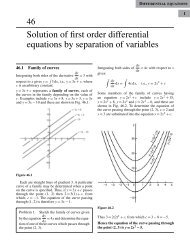integration
Create successful ePaper yourself
Turn your PDF publications into a flip-book with our unique Google optimized e-Paper software.
380 INTEGRAL CALCULUS<br />
625<br />
=<br />
3 − 625 625<br />
4<br />
125<br />
2 − 125 =<br />
12<br />
125<br />
3 6<br />
( )( )<br />
625 6<br />
=<br />
= 5 12 125 2 = 2.5<br />
y =<br />
=<br />
1<br />
2<br />
1<br />
2<br />
∫ 5<br />
0<br />
∫ 5<br />
0<br />
∫ 5<br />
0<br />
y 2 1<br />
dx<br />
2<br />
=<br />
y dx<br />
∫ 5<br />
0<br />
∫ 5<br />
0<br />
(5x − x 2 ) 2 dx<br />
(5x − x 2 )dx<br />
(25x 2 − 10x 3 + x 4 )dx<br />
125<br />
6<br />
[<br />
] 5<br />
1 25x 3<br />
− 10x4 + x5<br />
2 3 4 5<br />
0<br />
=<br />
125<br />
6<br />
(<br />
1 25(125)<br />
− 6250 )<br />
+ 625<br />
2 3 4<br />
=<br />
= 2.5<br />
125<br />
6<br />
Hence the centroid of the area lies at (2.5, 2.5).<br />
(Note from Fig. 38.10 that the curve is symmetrical<br />
about x = 2.5 and thus x could have been determined<br />
‘on sight’.)<br />
Now try the following exercise.<br />
Exercise 151 Further problems on<br />
centroids<br />
In Problems 1 and 2, find the position of the centroids<br />
of the areas bounded by the given curves,<br />
the x-axis and the given ordinates.<br />
1. y = 3x + 2 x = 0, x = 4 [(2.5, 4.75)]<br />
2. y = 5x 2 x = 1, x = 4 [(3.036, 24.36)]<br />
3. Determine the position of the centroid of a<br />
sheet of metal formed by the curve<br />
y = 4x − x 2 which lies above the x-axis.<br />
[(2, 1.6)]<br />
4. Find the co-ordinates of the centroid of the<br />
area which lies between the curve y/x = x−2<br />
and the x-axis.<br />
[(1, −0.4)]<br />
5. Sketch the curve y 2 = 9x between the limits<br />
x = 0 and x = 4. Determine the position of<br />
the centroid of this area.<br />
[(2.4, 0)]<br />
38.6 Theorem of Pappus<br />
A theorem of Pappus states:<br />
‘If a plane area is rotated about an axis in its own<br />
plane but not intersecting it, the volume of the solid<br />
formed is given by the product of the area and the<br />
distance moved by the centroid of the area’.<br />
With reference to Fig. 38.11, when the curve y = f (x)<br />
is rotated one revolution about the x-axis between<br />
the limits x = a and x = b, the volume V generated<br />
is given by:<br />
volume V = (A)(2πy), from which, y =<br />
V<br />
2πA<br />
Figure 38.11<br />
Problem 9. (a) Calculate the area bounded by<br />
the curve y = 2x 2 , the x-axis and ordinates x = 0<br />
and x = 3. (b) If this area is revolved (i) about the<br />
x-axis and (ii) about the y-axis, find the volumes<br />
of the solids produced. (c) Locate the position<br />
of the centroid using (i) <strong>integration</strong>, and (ii) the<br />
theorem of Pappus.<br />
(a) The required area is shown shaded in<br />
Fig. 38.12.<br />
Area =<br />
∫ 3<br />
0<br />
[ 2x<br />
3<br />
=<br />
3<br />
y dx =<br />
] 3<br />
0<br />
∫ 3<br />
0<br />
2x 2 dx<br />
= 18 square units










